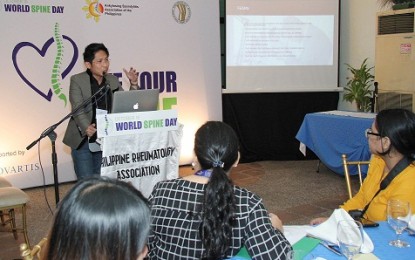Health
Group raises awareness on rare type of arthritis

FILE: Clark Ferrer, president of Ankylosing Spondylitis Association of the Philippines (ASAPh), discusses his group’s advocacy to help people with this rare type of arthritis. (PNA photo by Gil Calinga,via PNA)
MANILA – In line with the Tuesday’s celebration of the World Spine Day, a health advocacy group is now raising awareness about a rare form of arthritis which affects the spine.
The disease, Ankylosing Spondylitis (AS), is so rare that it only affects 2 percent of the global population, according to the Philippine Rheumatology Association (PRA).
Clark Ferrer, president of the Ankylosing Spondylitis Association of the Philippines (ASAPh), said this prompted him to launch the public awareness drive about the disease.
“Being a person with the disease, natatakot ako na ang mga may AS na gaya ko ay hindi sila aware na meron sila nito. Sana maagapan kasi may kakilala ako na tatlong taon nang nakahiga lang pero hindi pa rin niya alam na may AS siya (I fear that people with AS like me are unaware that they have it. I hope it will be detected early because I know someone who has been bedridden for three years but he doesn’t know that he has AS),” Ferrer told Philippine News Agency (PNA) in an interview.
The group, which engages the government and private health sectors in disseminating information about AS and provide financial support to AS patients, signed a memorandum of understanding (MOU) with the PRA and Novaritis Healthcare Philippines to promote the early diagnosis and prompt treatment of the disease.
Ferrer said he was only 12 years old when he first experienced severe hip pain which is one of the major symptoms of AS.
He added that the pain caused him to be bedridden for three months and it recurred five more times after he has recovered from the first episode.
“It was only recently that I was diagnosed with AS after consulting a rheumatologist. It makes you unproductive, helpless and depressed. So, I thought of partnering with the government and the private sector because we can’t do everything on our own,” he said.
Novaritis chief scientific officer Francis Domingo said the awareness on AS is low as it takes around eight years before an AS patient is properly diagnosed with the disease.
“All concerned stakeholders need to work together to promote early diagnosis and treatment by a rheumatologist and prevent irreversible damage,” he said.
Meanwhile, PRA president Julie Li-Yu explained how inflammatory back pain caused by AS is different from a regular or mechanical back pain caused by physical activities.
“Symptoms will always include back pain accompanied by other AS symptoms like eye problems, colon infections, psoriasis, heart problems so we work closely with gastroentologists, ophthalmologists, dermatologists and cardiologists,” she said.
Li-Yu added that AS is a hereditary disease which affects both children and adults, adding its symptoms often manifests during the productive years of the patients.
Emphasizing the severe pain from an inflammatory backache, Li-Yu said AS patients’ are unable to do move freely and do simple things for themselves like tying their shoe laces, getting dressed or turning their heads when driving.
“There’s no cure but we can try to control the disease. We want to catch patients during their inflammatory back pain stages especially those in young teens and early adults. Early recognition is best so we can delay the progression of the disease, there are drugs we could offer but not just pain relievers because they won’t be enough,” she added.





















